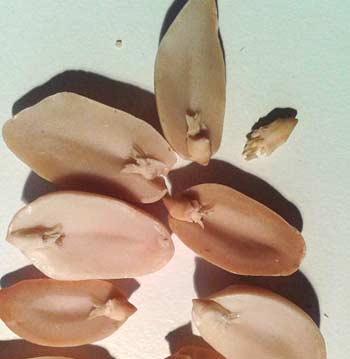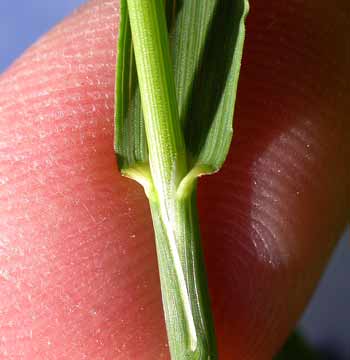Seeds - Sexual Propagation!
This is not a lesson in plant biology, or a scientific paper. It is simply a brief explanation of what comes out of a seed packet or wherever. To grow plants from seeds, we must have seeds as our raw material, so it would be a good idea to know a little bit about them.
If you do an in-depth study of seeds, you cannot but notice the similarities there are between the method of seed production of plants, and the normal reproduction of animals - humans included. (We do after all share around 60% of our DNA with plants and our DNA is more similar than dissimilar.)
For instance the genes that tell us whether it is light or dark are also present in plants. One of the reasons why plants can react to either dark or light situations!
All Seeds are the result of sexual activity, highlighted by the fact that we have two basic categories of propagating plants - sexual, by seed and asexual, by taking cuttings. In propagating by seeds we are using the end result of a male and female plant doing what comes naturally. Or, sometimes a male and female flower both on the same plant, or even by a single flower having both male and female reproductive parts. They are way ahead of us in some respects!
 There is more; much more; but not for this page. Here we are simply
concerned about getting that dormant seed to complete its life cycle,
and develop into a plant. (At first I wrote 'turn into a plant' which is
technically wrong because the seed is already an embryonic plant -
simply waiting to be born.)
There is more; much more; but not for this page. Here we are simply
concerned about getting that dormant seed to complete its life cycle,
and develop into a plant. (At first I wrote 'turn into a plant' which is
technically wrong because the seed is already an embryonic plant -
simply waiting to be born.)
Young Embryo Plants in Waiting.
There are two basic types of seeds. The main group has two distinct halves to the seed, and the embryo plant is enclosed between them – a ‘bud’ from which grows a root, a stem and leaves. If you carefully split a pea or bean seed into two halves, the bud is quite visible. The seeds with two halves are called dicotyledons. These are the main group of plants which we use in the garden – in particular for flowering plants.
The other – no less important – group, do not have two halves, but a ‘whole’ mass that encircles the embryo. This group includes all of the grasses and cereal crops.
 Upon
germination, the difference is highlighted, in that the dicotyledons
emerge with two dicotyledons ‘leaves – the two halves of the seed. They
often bring the seedcoat to the surface of the soil. Their life depends
upon getting those two cotyledons to the surface, acting as a food
store, until the ‘true leaves emerge to take over the running of things.
Upon
germination, the difference is highlighted, in that the dicotyledons
emerge with two dicotyledons ‘leaves – the two halves of the seed. They
often bring the seedcoat to the surface of the soil. Their life depends
upon getting those two cotyledons to the surface, acting as a food
store, until the ‘true leaves emerge to take over the running of things.
The grasses on the other hand, send up a single rolled shoot from within the seed which normally stays in the soil as a primary food source for the shoot to develop above ground. That rolled up shoot then develops into the long grassy leaves that are typical of the plants. This type of seed – monocotyledon – has a richer food source within the seed, which is the basic reason why cereal crops are important as staple foods for a huge area of this planet.
More to follow
Related Articles
- Growing Seeds - Much better than simply 'sowing' seeds!
- Seeds Germination - This is where we play our part.
- Sowing Seeds - the 'physical' practicalities.
- Grow Geraniums from seed
Best Selling Gardening Products
Popular Gardening Sections

Problems
Identify Weeds in The Garden - How to deal with weeds. Diseases and Pest which harm your garden and plants, learn how to prevent, deter and erradicate your garden problems.
Garden Problems
Pruning
Pruning Guide. Shrubs flower better with correct pruning. Many illustrations and examples of what to do - and when. Includes evergreens, roses, flowering shrubs, spring flowering shrubs and pruning for stem effect. This is our most viewed and comprehensive section,
Pruning
Gardening Businesses
Gardening Businesses listed in the UK counties and USA states. County and State Listings of businesses involved in Garden supplies and services. If you wish to be added to the Directory, please send us your information. Having problems, use the search box
Businesses
Gardening
In this section you will learn about Gardening Basics, Containers, Landscaping, Propagation and Soil.
Gardening
Gardening Gifts
Gardening Gifts and Reviews, Read Before you Buy
- Gardening Gifts Ideas
- Gifts For Her
- Gifts For Men
- Power Tool Gifts
- Cheap Gifts
- Personalised Gifts
- Wildlife Gifts
- Family Gifts



